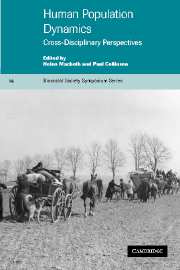Book contents
- Frontmatter
- Contents
- List of contributors
- Foreword by G.A. Harrison
- Preface
- 1 Introduction: the framework of studying human population dynamics
- 2 Demographic perspectives on human population dynamics
- 3 The growing concentration of world population from 1950 to 2050
- 4 Population, community and society in peasant societies
- 5 From genetic variation to population dynamics: insights into the biological understanding of humans
- 6 Social institutions and demographic regimes in non-industrial societies: a comparative approach
- 7 The dynamics of child survival
- 8 Genetic structure of south Indian caste populations: a confluence of biology and culture
- 9 Fertility, mortality and migration transitions in association with socioeconomic modernisation among highland minority populations in Southeast Asia
- 10 Ecology, homeostasis and survival in human population dynamics
- Glossary
- Index
- References
3 - The growing concentration of world population from 1950 to 2050
Published online by Cambridge University Press: 11 August 2009
- Frontmatter
- Contents
- List of contributors
- Foreword by G.A. Harrison
- Preface
- 1 Introduction: the framework of studying human population dynamics
- 2 Demographic perspectives on human population dynamics
- 3 The growing concentration of world population from 1950 to 2050
- 4 Population, community and society in peasant societies
- 5 From genetic variation to population dynamics: insights into the biological understanding of humans
- 6 Social institutions and demographic regimes in non-industrial societies: a comparative approach
- 7 The dynamics of child survival
- 8 Genetic structure of south Indian caste populations: a confluence of biology and culture
- 9 Fertility, mortality and migration transitions in association with socioeconomic modernisation among highland minority populations in Southeast Asia
- 10 Ecology, homeostasis and survival in human population dynamics
- Glossary
- Index
- References
Summary
Introduction
The beginning of the twenty-first century is a most opportune time to look back fifty years to see what has happened to the spatial patterns of world population distribution, and to try to look forward over a similar period to see what is likely to happen, especially as we are in the midst of an almost inexorable process of massive concentration of world population. That concentration must be examined within the context of other enormous demographic changes that have taken place since 1950 and are likely to take place before 2050. Naturally, the reliability of the retrospective analysis is greater than that of the prospective analysis, although I am relieved to note that most of my speculations and predictions made in comparable papers about three decades ago (Clarke 1971, 1972) have not been far from the mark. As Hinde (Chapter 2) has mentioned, the perspectives of demographers and geographers overlap, but the latter pay great attention to spatial distribution and migration.
Rapid world population growth
The mid-twentieth century was a demographic threshold when world population growth accelerated. At that time, the world population was just over 2.5 billion; according to the United Nations Population Division it reached 6 billion in October 1999. It had taken roughly a century and a half for world population to multiply two and a half times from 1 billion to 2.5 billion, but in the second half of the twentieth century the world population grew so rapidly that 3.5 billion were added to the world total, one billion being added during the last 12 years (Table 3.1).
- Type
- Chapter
- Information
- Human Population DynamicsCross-Disciplinary Perspectives, pp. 41 - 64Publisher: Cambridge University PressPrint publication year: 2002
References
- 3
- Cited by



